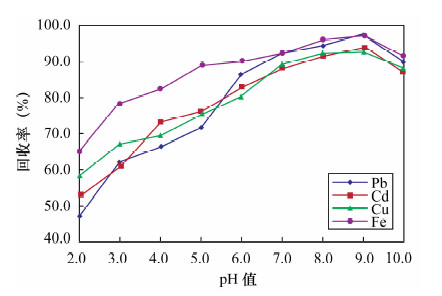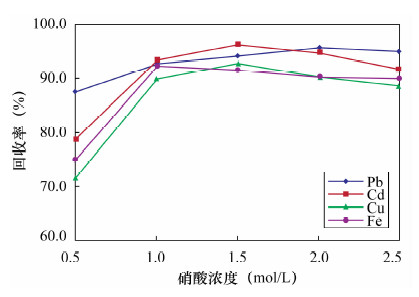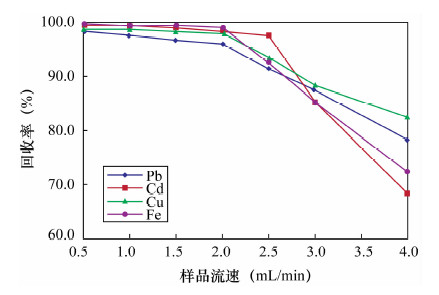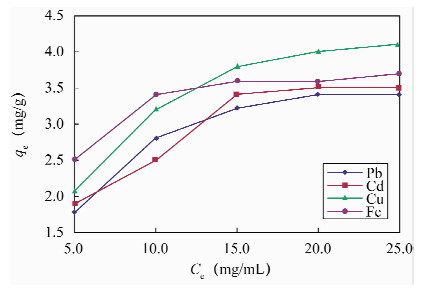| [1] |
Sprynskyy M, Buszewski B, Terzyk A P. Study of the selection mechanism of heavy metal (Pb2+, Cu2+, Ni2+ and Cd2+) adsorption on clinoptilolite [J].Journal of Colloid and Interface Science, 2006, 304(1):21-28. doi: 10.1016/j.jcis.2006.07.068
CrossRef Google Scholar
|
| [2] |
Liang P, Sang H B. Determination of trace lead in biological and water samples with dispersive liquid-liquid microextraction preconcentration [J].Analytical Bio-chemistry, 2008, 380:21-25.
Google Scholar
|
| [3] |
Naseii M T, Hosseini M R, Assadi Y, Kiani A. Rapid determination of lead in water samples by dispersive liquid-liquid microextraction coupled with electrothermal atomic absorption spectrometry[J].Talanta,2008,75:56-62. doi: 10.1016/j.talanta.2007.10.029
CrossRef Google Scholar
|
| [4] |
Liang P, Zhao E H, Li F. Dispersive liquid-liquid microextraction preconcentration of palladium in water samples and determination by graphite furnace atomic absorption spectrometry[J].Talanta, 2009, 77:1854-1857. doi: 10.1016/j.talanta.2008.10.033
CrossRef Google Scholar
|
| [5] |
台希, 李海涛, 李德良, 胡秋芬, 杨光宇, 尹家元. 固相萃取富集高效液相色谱法测定环境水样中的重金属元素[J].干旱环境监测, 2004, 32(2):67-70.
Google Scholar
|
| [6] |
Wu Y W, Jiang Y Y, Wang F, Han D Y. Extraction of chromium, copper, and cadmium in environmental samples using cross-linked chitosanbound FeC nano-particles as solid-phase extractant and determination by flame atomic absorption spectrometry [J].Atomic Spectroscopy, 2007, 28(5):183-188.
Google Scholar
|
| [7] |
黄海涛, 李忠, 陈章玉, 王保兴, 施红林, 杨光宇. 固相萃取富集-高效液相色谱法测定烟草和烟草添加剂中的重金属元素[J].理化检验(化学分册),2004,40(5):251-254.
Google Scholar
|
| [8] |
杨亚玲, 杨国荣, 胡秋芬, 杨光宇, 尹家元. 固相萃取富集-高效液相色谱法测定4种中草药中的重金属元素[J].药物分析杂志, 2004, 24(4):441-443.
Google Scholar
|
| [9] |
周骁腾, 侯静怡, 卢恒, 刘金欣, 魏英勤, 孟繁蕴. 萃取技术在中药材重金属检测样品前处理中应用[J].中医药导报, 2013, 19(5):5-7.
Google Scholar
|
| [10] |
Anastassiades M, Lehotay S J, Stajnbaher D, Schenck F J. Fast and easy multiresidue method employing acetonitrile extraction/partitioning and "dispersive solid-phase extraction" for the determination of pesticide residues in produce[J].Journal of AOAC International, 2003, 86(2):412-431.
Google Scholar
|
| [11] |
Nigel J K S. Solid-Phase Extraction: Principles, Tech-niques, and Applications [M].New York: Marcel Dekker Inc, 2000.
Google Scholar
|
| [12] |
成会明. 纳米碳管——制备、结构、物性及应用[M]. 北京:化学工业出版社, 2002.
Google Scholar
|
| [13] |
Endo M, Takeuchi K, Kobori K, Katsushi T, Harold W K, Sarkar A. Pyrolytic carbon nanotubes from vapor-grown carbon fibers [J].Carbon, 1995, 33:873-881. doi: 10.1016/0008-6223(95)00016-7
CrossRef Google Scholar
|
| [14] |
辜萍, 王宇, 李广海. 碳纳米管的力学性能及碳纳米管复合材料研究[J].力学进展, 2002, 32(4):563-568. doi: 10.6052/1000-0992-2002-4-J2001-114
CrossRef Google Scholar
|
| [15] |
朱宏伟, 吴德海, 徐才录. 碳纳米管(第一版)[M]. 北京:机械工业出版社, 2003.
Google Scholar
|
| [16] |
Chen W, Duan L, Zhu D. Adsorption of polar and non-polar organic Chemicals to carbon nanotubes[J].Environmental Science & Technology, 2007, 41(24):8295-8300.
Google Scholar
|
| [17] |
Yang K, Wang X L, Zhu L Z, Xing B S. Competitive sorption of pyrene, phenanthrene, and naphthalene on multiwalled carbon nanotubes[J].Environmental Science & Technology, 2006, 40(18):5804-5810.
Google Scholar
|
| [18] |
Li Y H, Ding J, Luan Z K, Di Z C, Zhu Y F, Xu C L, Wu D H, Wei B Q. Competitive adsorption of Pb2+, Cu2+and Cd2+ions from aqueous solutions by multiwalled carbon nanotubes[J].Carbon, 2003, 41(14):2787-2792. doi: 10.1016/S0008-6223(03)00392-0
CrossRef Google Scholar
|
| [19] |
Peng X J, Luan Z K, Di Z C, Zhang Z Z, Zhu C L. Carbon nanotubes-iron oxides magnetic composites asadsorbent for removal of Pb(Ⅱ) and Cu(Ⅱ) from water[J].Carbon, 2005, 43(4):880-883. doi: 10.1016/j.carbon.2004.11.009
CrossRef Google Scholar
|
| [20] |
Lu C, Chiu H, Liu C. Removal of zinc(Ⅱ) from aqueous solution by purified carbon nanotubes: Kinetics and equilibrium studies [J].Industrial & Engineering Chemistry Research, 2006, 45(8):2850-2855.
Google Scholar
|
| [21] |
Rao G P, Lu C, Su F. Sorption of divalent metal ions from aqueous solution by carbon nanotubes: A review[J].Separation and Purification Technology, 2007, 58(1):224-231. doi: 10.1016/j.seppur.2006.12.006
CrossRef Google Scholar
|
| [22] |
Fu F L, Wang Q. Removal of heavy metal ions from wastewaters: A review[J].Journal of Environmental Management, 2011, 92:407-418.
Google Scholar
|
| [23] |
Maquieira A, Elmahadi H A M, Puchades R. Imm-obilized cyanobacteria for online trace metal enrichment by flow injection atomic absorption spectrometry [J].Analytical Chemistry, 1994, 66(21):3632-3638. doi: 10.1021/ac00093a016
CrossRef Google Scholar
|
| [24] |
Mohan D, Pittman C U, Bricka M, Smith F, Yancey B, Mohammad J, Steele P H, Alexandre-Franco M F, Gomez-Serrano V, Gong H.Sorption of arsenic, cadmium, and lead by chars produced from fast pyrolysis of wood and bark during bio-oil production[J].Journal of Colloid Interface Science, 2007, 310:57-73. doi: 10.1016/j.jcis.2007.01.020
CrossRef Google Scholar
|
| [25] |
Rao M M, Ramana D K, Seshaiah K, Wang M C, Chien S W C. Removal of some metal ions by activated carbon prepared from Phaseolus aureus hulls[J].Journal of Hazard Materials, 2009, 166:1006-1013. doi: 10.1016/j.jhazmat.2008.12.002
CrossRef Google Scholar
|
| [26] |
Ayala J, Blanco F, Garcia P, Rodriguez P, Sancho J. Asturian fly ash as a heavy metals removal material[J].Fuel, 1998, 77:1147-1154. doi: 10.1016/S0016-2361(98)00027-1
CrossRef Google Scholar
|
| [27] |
Pavasant P, Apiratikul R, Sungkhum V, Suthiparinya-nont P, Wattanachira S, Marhaba T F. Biosorption of Cu2+, Cd2+, Pb2+, and Zn2+ using dried marine green macroalga caulerpa lentillifera[J].Bioresource Technology, 2006, 97:2321-2329. doi: 10.1016/j.biortech.2005.10.032
CrossRef Google Scholar
|







 DownLoad:
DownLoad:


